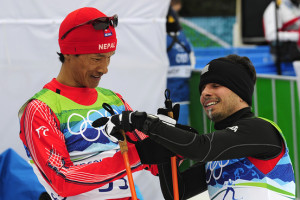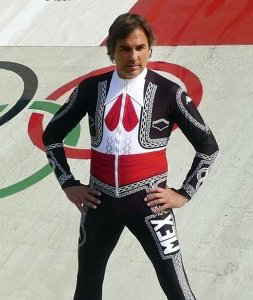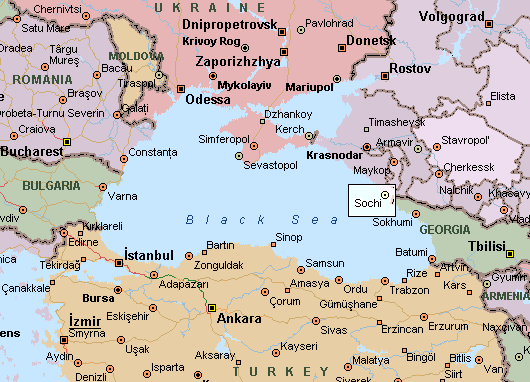print Print...

Dachhiri Sherpa, left, with Portuguese skier Danny Silva at the 2010 Vancouver Winter Olympics.
(from Canada .com) – KRASNAYA POLYANA, Russia – For Nepali cross-country skier Dachhiri Sherpa – who finished 92nd and 94th in his previous two Olympic Winter Games races – there is clearly plenty of room for improvement.
Yet whatever the Himalayan bricklayer’s result will be in the 15-km classic in Sochi on Feb. 14, he will remain a hero to the minority of Nepalis aware of his existence.
“I have taken four months off work and skied every single day since December to train for this event, but I’m not perfect,” he told reporters here in the mountains near Sochi. “I think there is a very big chance I will finish last. But the placing is not important if I can teach young people in Nepal about the Olympic spirit. This spirit is in my heart.”
Sherpa may be the lone athlete competing for Nepal in Sochi, but his situation isn’t all that unusual. There are 16 other countries in Sochi represented by just one athlete: Bermuda, Cayman Islands, Hong Kong, Kyrgyzstan, Luxembourg, Malta, Mexico, Pakistan, Paraguay, Philippines, Tajikistan, Tonga, Venezuela, the Virgin Islands (both U.S. and British) – and Zimbabwe.
Yes, Zimbabwe, which is among seven nations taking part in the Winter Olympics for the first time.

There are another 27 countries with five or fewer athletes in Sochi, among them summer nations like Bermuda and Jamaica, which made its debut at the Winter Olympics in Calgary in 1998, when a team of sprinters entered the four-man bobsleigh competition. …
While some athletes are competing for small countries courtesy of dual citizenship – like Paraguayan slopestyler Julia Marino, who was raised in the U.S. but was unable to qualify for the U.S. freestyle skiing team, and B.C.’s Sean Greenwood, who will compete in skeleton as part of Ireland’s five-member team – others have battled the odds from within their own countries.
Michael Christian Martinez is the first Filipino to compete at an Olympic Games since Albertville in 1992 – and the first ever to compete in figure skating. He learned how to skate in a shopping mall.
“I started skating in 2005 when I was nine-years-old. We were in a shopping mall and I saw other skaters jumping and spinning. I wanted to try it,” said the 17-year-old, who is also the youngest figure skater in the men’s event. “When I stepped on the ice, I fell right away. But then I got up and started stroking around the rink,” he said. “I loved the sport.”
Short track speed skater Pan To Barton Lui – who will become the first and only man to compete for Hong Kong – took up the sport after watching the 2010 Games. Despite the wishes of his parents, he convinced them to let him quit school, move away from home and start training. He calls himself a “one-man army.”

Hubertus von Hohenlohe will wear a unique race suit inspired by Mexican folk music at Sochi 2014. Also, at 55, he will become the second-oldest Winter Olympian in history at Sochi 2014. The oldest was a Swedish curler named Carl August Kronlund, born in 1865, who was 58 when he competed at the inaugural Games of 1924.
Mexico’s Hubertus Von Hohenlohe is used to competing on his own – he’s almost singlehandedly upheld Mexican national interest in the Winter Olympics since founding the Mexican Ski Federation in 1981, shortly before he qualified for the 1984 Sarajevo Games. At three of the six Winter Olympics he’s attended, he’s been Mexico’s only competing athlete.
Indian luger Shiva Keshavan somehow managed to make it to the Olympics, despite the fact his country lacks a luge track. The 32-year-old often trains with a sled on wheels, forced to dodge goats and trucks while shooting down steep Himalayan roads.
But Sherpa’s path to Sochi may be the most unconventional. He was born in the Sherpa village of Chulemo at the foot of Mount Everest – a four-day walk from the nearest road – and raised in a local monastery. At 17, he started work as an assistant cook for tourist trekking expeditions.
“When I was young, I could never have imagined what would happen in my life,” said Sherpa, who did not try on a pair of skis until he was 33.
“Things first changed when some tourists from the Netherlands paid for me to do a course to become a mountain guide. Then a few years later, I started running.”
Sherpa was good at running. He began on the gruelling climbs of the Himalayas and later raced on trails in Europe, where he settled in Switzerland. Nepal’s Olympic Committee read about Sherpa’s sporting feats in a local newspaper and contacted him with an offer to compete in the Aomori 2003 Asian Winter Games in Japan.
“I was interested and asked what running distance they wanted me to do. I was quite surprised when they said it was for skiing,” he recalled. “I had never done it before. They said ‘do some training and you will be OK’.”
 The training consisted of six lessons, each lasting two hours. Then, a mere three months after meeting the Olympic officials, Sherpa travelled to Aomori to compete. “It was very hard to finish the race in Japan, but I did it. It took a long time.”
The training consisted of six lessons, each lasting two hours. Then, a mere three months after meeting the Olympic officials, Sherpa travelled to Aomori to compete. “It was very hard to finish the race in Japan, but I did it. It took a long time.”
And Sherpa kept on racing.
At Turin in 2006, he became the second Nepali to compete at an Olympic Winter Games. He raced again in 2010. Now he is seeking a successor.
“At 44, this will be my last Olympics. I need to find the next young talent. The problem is that most people in Nepal can’t watch international TV, so very few people will see the race. Plus, there is no place to ski in Nepal.”
Even in winter sports-mad Switzerland, Sherpa’s workmates on the building site cannot fathom why he is travelling to Russia to compete in a race he appears certain to lose.
“Half of my colleagues don’t understand why I am doing this. For them, work is very important and to take time off is hard. But some people don’t think big. I have to sacrifice a lot of things: energy, time and of course money. But not many people get this opportunity. In life, between money and the values of the Olympics, which is more important?”
With files from Olympic News Service and Christie Blatchford, Postmedia News.
Reprinted here for educational purposes only. May not be reproduced on other websites without permission from Canada .com. Visit the website at canada.com.
Questions
NOTE: Today’s Daily News Article is a human interest story. Human interest stories differ from the regular news – they are sometimes referred to as “the story behind the story.”
The major news articles of the day tell of important happenings. Human interest stories tell of how those happenings have impacted the people or places around the story.
1. a) How many countries have only one athlete competing in the 2014 Winter Olympic games?
b) List the countries.
2. How many countries have athletes competing in the Winter Olympics for the first time ever?
3. How many athletes do we have competing from the U.S.?
4. a) In what sport will Hong Kong’s Pan To Barton Lui compete?
b) When did he take up the sport?
5. In what sport will Nepal’s Dachhiri Sherpa compete?
6. a) How did Mr. Sherpa do the two previous times he competed in the Winter Olympics?
b) How does Mr. Sherpa think he will do this time? (What did he say?)
c) Knowing that he will not do well, why does Mr. Sherpa compete?
7. The Olympic Games are for amateur athletes. Do you think it is OK for an athlete to compete for his/her country if he no longer lives in that country? Explain your answer.
8. How does this article inspire you?
9. Mr. Sherpa said, “At 44, this will be my last Olympics. I need to find the next young talent. The problem is that most people in Nepal can’t watch international TV, so very few people will see the race. Plus, there is no place to ski in Nepal.”
a) Does this information change your opinion of Mr. Sherpa’s participation in the Winter Olympics? Explain your answer.
b) What are some ways these challenges could be addressed?
Resources
- Visit the Sochi website for a list of all athletes competing: sochi2014.com/en/teams
- For info about the U.S. Olympic team, go to: teamusa.org
- Read 10 interesting facts about the Olympics: usatoday.com/2014/02/winter-olympics-medal-count-sochi-all-time-facts
- Read the IOC Citizenship rules for athletes: en.wikipedia.org/wiki/Olympic_Games#Citizenship
- Visit the IOC website at: olympic.org/ioc
Daily “Answers” emails are provided for Daily News Articles, Tuesday’s World Events and Friday’s News Quiz.



